The Long Haul Solutions Market is estimated to be valued at USD 9458.2 million in 2025 and is projected to reach USD 22805.3 million by 2035, registering a compound annual growth rate (CAGR) of 9.2% over the forecast period.
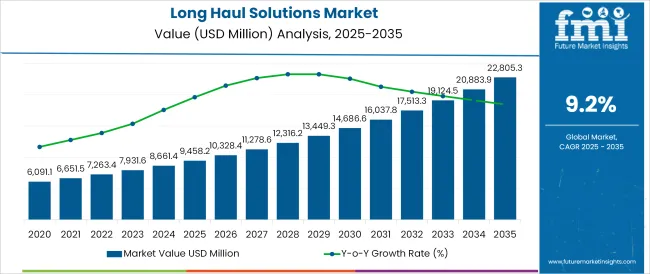
The long haul solutions market is advancing due to the rapid expansion of data-intensive services like cloud computing, video streaming, and enterprise-wide connectivity. Emphasis on network scalability and ultra-reliable, low-latency data transmission has heightened demand for long-reach fiber, DWDM systems, and advanced optical amplification technologies.
Data-center interconnects, 5G backhaul, and edge computing deployments are creating strong demand in core transport infrastructure. Key industry players and network operators have initiated modernization programs aimed at increasing capacity and energy efficiency while reducing operational expenditures per bit. Regulatory and security mandates tied to critical infrastructure and national broadband expansion are encouraging investment in robust optical transport networks.
Future market prospects are expected to be robust, driven by AI- and IoT-enabled traffic growth, alongside innovation in programmable coherent optics, artificial intelligence-based network optimization, and integration of packet-optical solutions across multiple network layers.
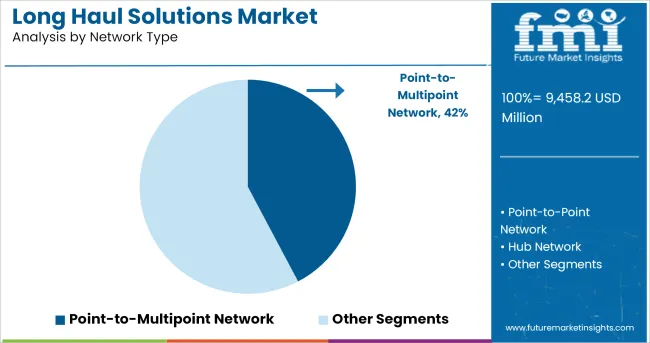
It is observed that the point‑to‑multipoint network format accounts for 42.30% of total market revenue, making it the leading network type. This prominence is explained by its efficient capacity distribution across multiple nodes, enabling cost-effective scaling of backbone and metro transport infrastructure.
Service providers have been drawn to its flexibility for supporting dynamic traffic patterns such as multicast video, content distribution and multi-site cloud connectivity without requiring redundant point-to-point links. Additionally, advances in programmable ROADMs, elastic filtering, and sliceable bandwidth have reinforced its deployment.
The consolidation of data flows through centralized hubs has further reduced operational complexity and power usage while ensuring resiliency. Consequently, preference for point-to-multipoint architectures has been reinforced, establishing this configuration as the dominant network type.
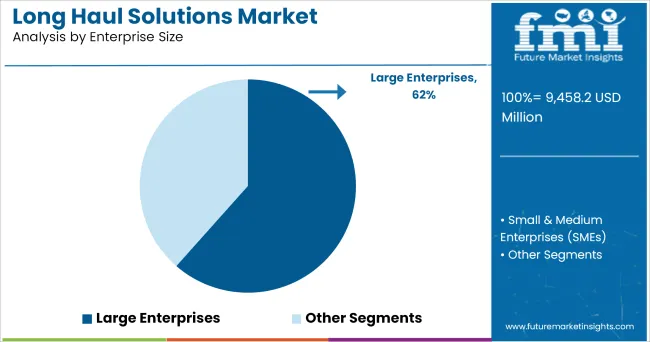
It has been observed that large enterprises represent 61.50% of market revenue, positioning them as the dominant buyer segment. This is driven by their requirement for high-capacity, secure wide area connectivity across multiple branches and data centres, which can only be met through advanced long haul solutions.
Large organizations have been acknowledged as having the financial wherewithal to invest in redundant optical paths, Service-Level Agreements (SLAs) and managed services, while leveraging economies of scale to justify infrastructure upgrades.
Tight integration between transport networks and enterprise WAN and cloud environments has been facilitated through MPLS, SD‑WAN and optical overlays further encouraging adoption. As a result, large enterprises have anchored market growth by driving deployment of next-generation, mission-critical transport services.
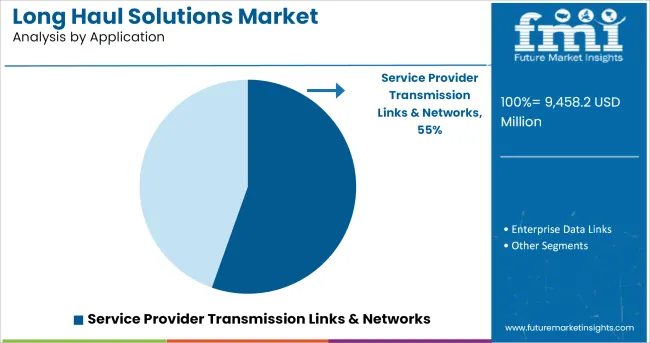
It is noted that the service provider transmission links & networks vertical accounts for 55.40% of the overall market, making it the leading application segment. This performance is attributed to their central role in supporting cross-border, long-distance traffic aggregation and backhaul from 5G nodes, content delivery networks, and mobile-edge locations.
Investments in submarine cables, terrestrial long-distance DWDM systems, and open line systems have been prioritized by operators seeking transparent, vendor-agnostic solutions. Adoption of disaggregated optical transport architectures and open APIs has further accelerated deployments that enable service-level customization and vendor diversity.
Operational cost savings, improved bandwidth efficiency, and seamless scalability have also been realized through intelligent network design and modular upgrades. Accordingly, service providers have reinforced their leadership in the market by driving infrastructure modernization and remote connectivity initiatives
The extensive usage of fiber optics communication is rapidly increasing the demand for telecommunication capacity and internet services, which is contributing to the growth of long haul solutions sales. Rapid developments in the telecommunication infrastructure of various emerging economies around the world is supporting the demand for long haul solutions.
Long haul solutions helps minimize downtime and enhance production and also aids to bridge the digital gap cost effectively and quickly by enabling smooth migration to all-IP networks. With long haul solutions, colocation providers, over-the-top (OTT) providers, and service providers connect various customers to large colocation sites through cities and countries, thereby fueling the demand for long haul solutions across geographies.
Increase in adoption of optical communication, reduction in capital investment, and rising demand for fast and reliable communication networks, are some key factors augmenting the demand for long haul solutions. The global long haul solutions demand is expanding owing to noteworthy innovations in telecommunication sector and rapid rise in constant developments. Several companies are making significant investments to develop appropriate technology for IT & telecom industry.
Furthermore, the extensive usage of fiber optics communication is rapidly increasing the demand for telecommunication capacity and internet services, which is contributing to the growth of long haul solutions adoption rate. Rapid developments in the telecommunication infrastructure of various emerging economies around the world is supporting the demand for long haul solutions.
Moreover, factors contributing to the growth of long haul solutions is that it offers excellent operations, administration, maintenance, and provisioning capabilities as well as enhanced solutions for multiplexing circuit-switched low-speed streams.
These developments have enabled the constant deployment of the large volume data transmission. Owing to the demand increment and technological developments there is an increasing deployment of long haul solutions. It is expected to rise in the long run, with the evolution of innovative and a lot of progressive long haul solutions.
Advances in technology to improve bandwidth and reduction in attenuation rate have created numerous opportunities for long haul solutions sales. High penetration of the technology in the manufacturing sector and expanding the IT and telecom sectors across the country are strengthening the long haul solutions demand. Moreover, the increasing application of fiber networks is catapulting growth across the nation, thus propelling the overall demand at a significant pace.
Additionally, operators from emerging economies, such as India, have been actively investing in optical fiber and related technologies, to meet the set standards. For instance, main drivers for the increase in deployment of long haul solutions in India are enhanced fiber-to-the-home (FTTH) deployments and increased 4G deployments in Tier-1 and Tier-2 cities by ISPs, MSO providers, and telecom operators.
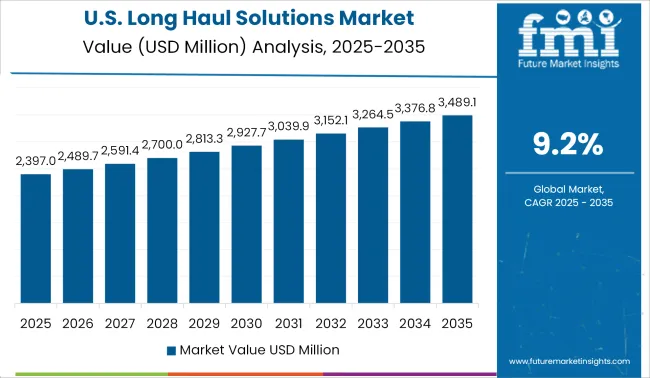
The North America region has emerged as a major cloud computing hub, and data center, which has ultimately made the region the largest consumer of long haul solutions. With high demand for data communication; robust presence of major companies in the region; increased use of communication devices, such as tablets and smartphones, as well as the increasing deployment of data centers and growing market for wearable devices drive the growth of long haul solutions in this region.
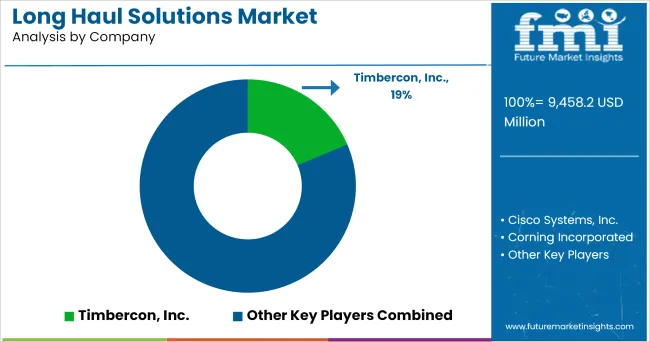
Some of the leading providers of long haul solutions include
Long-term agreements with business partners are expected to escalate revenue and new innovation strategies, which is likely to enable the providers of long haul solutions to reach new growth markets. Moreover, continuous technological innovations and the acquisition of businesses are also expected to help the providers of long haul solutions create value for their shareholders and to accelerate revenue growth.
The report is a compilation of first-hand information, qualitative and quantitative assessment by industry analysts, inputs from industry experts and industry participants across the value chain. The report provides in-depth analysis of parent market trends, macro-economic indicators and governing factors along with market attractiveness as per segments. The report also maps the qualitative impact of various market factors on market segments and geographies.
The global long haul solutions market is estimated to be valued at USD 9458.2 million in 2025.
The market size for the long haul solutions market is projected to reach USD 22805.3 million by 2035.
The long haul solutions market is expected to grow at a 9.2% CAGR between 2025 and 2035.
The key product types in long haul solutions market are point-to-multipoint network, point-to-point network, hub network and ring network.
In terms of enterprise size, large enterprises segment to command 61.5% share in the long haul solutions market in 2025.






Full Research Suite comprises of:
Market outlook & trends analysis
Interviews & case studies
Strategic recommendations
Vendor profiles & capabilities analysis
5-year forecasts
8 regions and 60+ country-level data splits
Market segment data splits
12 months of continuous data updates
DELIVERED AS:
PDF EXCEL ONLINE
Long-wear Glucose Sensors Market Size and Share Forecast and Outlook 2025 to 2035
Long-acting Depot Systems Market Size and Share Forecast Outlook 2025 to 2035
Long Wave Infrared Supercontinuum Laser Market Forecast and Outlook 2025 to 2035
Long-range Camera Market Forecast and Outlook 2025 to 2035
Long-Acting Beta-Agonists Market Size and Share Forecast Outlook 2025 to 2035
Long Term Evolution Base Station Market Size and Share Forecast Outlook 2025 to 2035
Long Term Post-Acute Care Software Market Size and Share Forecast Outlook 2025 to 2035
Long-term Care Software Market Size and Share Forecast Outlook 2025 to 2035
Long-Acting Monoclonal Antibodies Market Insights – Trends & Forecast 2024-2034
Oblong Tub Lids Market Size and Share Forecast Outlook 2025 to 2035
Market Share Insights of Oblong Tub Lids Product Providers
Oblong Jar Market
Oblong Container Market
EU Longevity Supplements Sales Analysis Size and Share Forecast Outlook 2025 to 2035
Curcuma Longa (Turmeric) Root Extract Market Size and Share Forecast Outlook 2025 to 2035
Complementary and Alternative Medicine for Anti Aging & Longetivity Market Size and Share Forecast Outlook 2025 to 2035
Road Haulage Market Size and Share Forecast Outlook 2025 to 2035
Heavy Haul Truck Market Analysis - Size, Share, and Forecast Outlook 2025 to 2035
Water Hauling Services Market Analysis by Application, End user and Region- Growth, Trends, and Forecast 2025 to 2035
Ethernet Backhaul Equipment Market Size and Share Forecast Outlook 2025 to 2035

Thank you!
You will receive an email from our Business Development Manager. Please be sure to check your SPAM/JUNK folder too.
Chat With
MaRIA